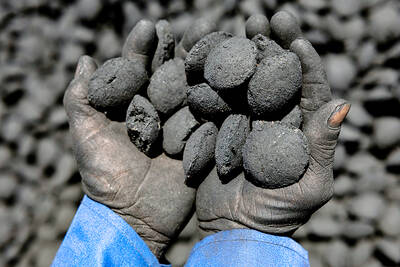SiPix Imaging Inc (鑼洤), an electronic paper subsidiary of the world’s No. 3 panel maker, AU Optronics Corp (友達光電), yesterday said it would ship a small volume of color e-paper displays in the second half of next year, ahead of most rivals.
The first color e-paper displays are expected to be used in electronic readers, magazines and newspapers, company president Andrew Tseng (曾旭文) told reporters on the sidelines of a workshop held by market researcher Topology Research Institute (拓墣產業研究所).
Like most of its competitors, SiPix currently only offers black-and-white e-paper displays, produced in the US.
“Making colored electronic paper displays is our top priority,” Tseng said. “We are in talks with customers to supply colored displays ... as [color] would encourage advertisers to place ads on [electronic] publications, which then would be able to provide more content [to readers] for free.”
After a breakthrough by AU Optronics in thin-film-transistor panels, SiPix expects to produce color displays next year, Tseng said, while rivals such as Prime View International Co (元太科技) may take two or three years to achieve the same goal.
Prime View is the world’s biggest supplier of e-paper display modules, with Amazon.com, Inc and Sony Corp among its customers.
Prime View makes e-paper displays using technology from E Ink Corp, which Prime View plans to acquire by the end of the year.
AU Optronics is scheduled to ship its first e-paper display modules to customers this quarter.
As a result of rising demand, SiPix chairman Liu Chun-ting (劉軍廷) last week said the company would boost production at its US plant next quarter and build a factory in Taiwan in the first half of next year.
“We are trying to increase capacity as much as possible, [to cope with demand],” Tseng said.
The e-paper market is expected to grow to US$832 million in 2012 in terms of revenue, up from US$2 million this year, Topology’s figures showed.

DIVIDED VIEWS: Although the Fed agreed on holding rates steady, some officials see no rate cuts for this year, while 10 policymakers foresee two or more cuts There are a lot of unknowns about the outlook for the economy and interest rates, but US Federal Reserve Chair Jerome Powell signaled at least one thing seems certain: Higher prices are coming. Fed policymakers voted unanimously to hold interest rates steady at a range of 4.25 percent to 4.50 percent for a fourth straight meeting on Wednesday, as they await clarity on whether tariffs would leave a one-time or more lasting mark on inflation. Powell said it is still unclear how much of the bill would fall on the shoulders of consumers, but he expects to learn more about tariffs

NOT JUSTIFIED: The bank’s governor said there would only be a rate cut if inflation falls below 1.5% and economic conditions deteriorate, which have not been detected The central bank yesterday kept its key interest rates unchanged for a fifth consecutive quarter, aligning with market expectations, while slightly lowering its inflation outlook amid signs of cooling price pressures. The move came after the US Federal Reserve held rates steady overnight, despite pressure from US President Donald Trump to cut borrowing costs. Central bank board members unanimously voted to maintain the discount rate at 2 percent, the secured loan rate at 2.375 percent and the overnight lending rate at 4.25 percent. “We consider the policy decision appropriate, although it suggests tightening leaning after factoring in slackening inflation and stable GDP growth,”

Meta Platforms Inc offered US$100 million bonuses to OpenAI employees in an unsuccessful bid to poach the ChatGPT maker’s talent and strengthen its own generative artificial intelligence (AI) teams, OpenAI CEO Sam Altman has said. Facebook’s parent company — a competitor of OpenAI — also offered “giant” annual salaries exceeding US$100 million to OpenAI staffers, Altman said in an interview on the Uncapped with Jack Altman podcast released on Tuesday. “It is crazy,” Sam Altman told his brother Jack in the interview. “I’m really happy that at least so far none of our best people have decided to take them

As they zigzagged from one machine to another in the searing African sun, the workers were covered in black soot. However, the charcoal they were making is known as “green,” and backers hope it can save impoverished Chad from rampant deforestation. Chad, a vast, landlocked country of 19 million people perched at the crossroads of north and central Africa, is steadily turning to desert. It has lost more than 90 percent of its forest cover since the 1970s, hit by climate change and overexploitation of trees for household uses such as cooking, officials say. “Green charcoal” aims to protect what